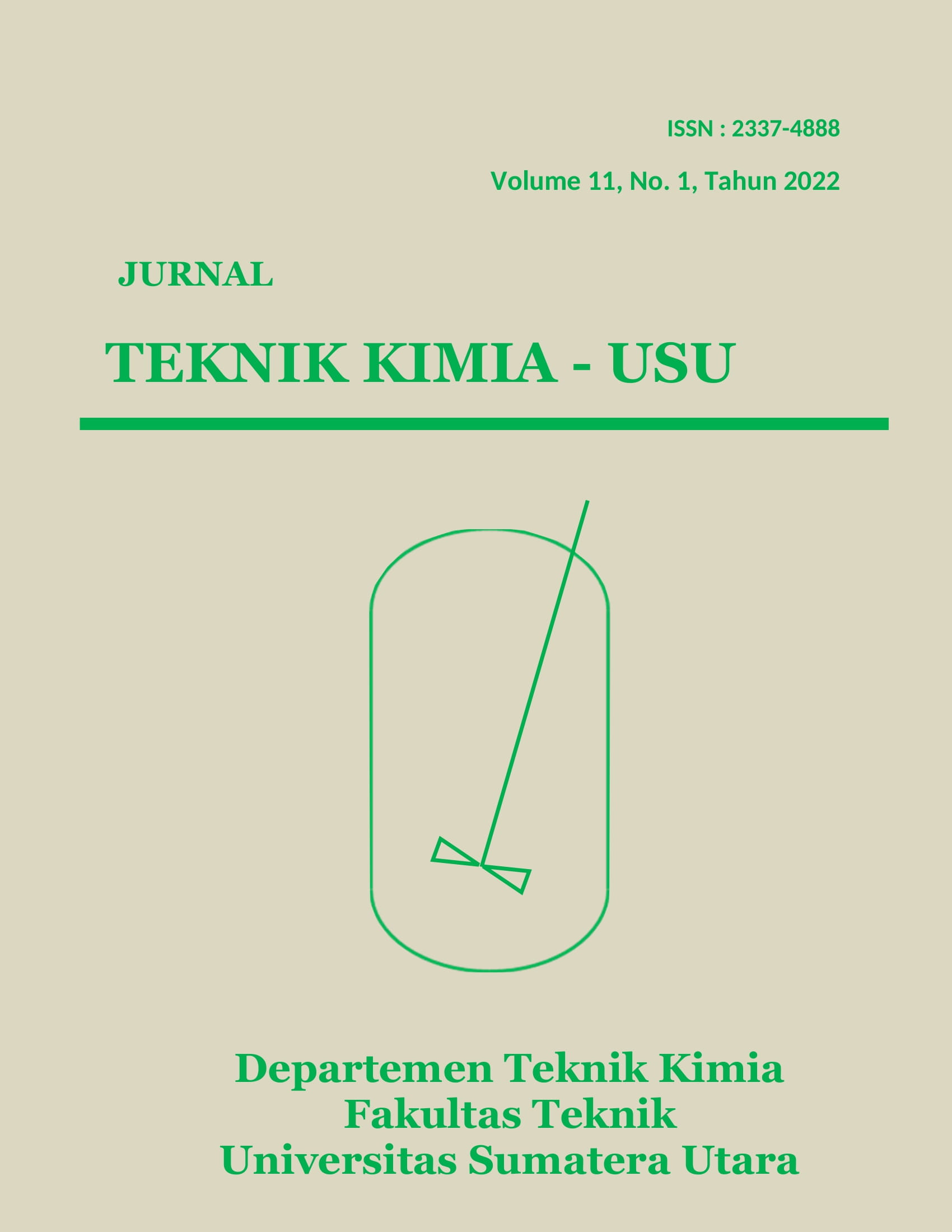Pengaruh Penambahan Minyak Kelapa Murni terhadap Sifat Perekat Berbahan Dasar Tepung Tapioka
DOI:
https://doi.org/10.32734/jtk.v11i1.8067Keywords:
bioadhesive, cassava starch, virgin coconut oilAbstract
Wood adhesive has significant contribution in the development of furniture industries. Currently, the most widely used type of adhesives is synthetic adhesive which is carcinogenic to humans. This research aimed to develop cassava starch-based bioadhesive. The additive added to the adhesive was virgin coconut oil (VCO) which had antibacterial and antifungal properties. The research method used is quantitative approach where adhesives were made and the properties were analyzed. The steps of making the adhesives included hydrolysis reaction, oxidation, and VCO addition. The reaction was carried out at 70 ℃ and atmospheric pressure for 90 minutes. The amount of VCO added were varied to 0%, 10%, 15%, 20%, 25%, and 30% of the weight of cassava starch. The properties measured were viscosity, solid content, shelf life, shear strength, and the molecular structure of the adhesives. The results showed that the addition of VCO improved the shelf life of the adhesive but weakened the shear strength of the adhesive. The amount of VCO that should be added to improve the adhesive quality is 10% of the weight of cassava starch.
Downloads
References
A. Kaboorani and B. Riedl, “Effects of adding nano-clay on performance of polyvinyl acetate (PVA) as a wood adhesive,†Compos. Part A Appl. Sci. Manuf., vol. 42, no. 8, pp. 1031–1039, 2011.
Q. Xu, J. Wen, and Z. Wang, “Preparation and properties of cassava starch-based wood adhesives,†BioResources, vol. 11, no. 3, pp. 6756–6767, 2016.
A. P. Haag, G. G. Geesey, and M. W. Mittleman, “Bacterially derived wood adhesive,†Int. J. Adhes. Adhes., vol. 26, no. 3, pp. 177–183, 2006.
S. Ebnesajjad, Adhesive Technology Handbook, vol. 148.
H. Yu, Q. Fang, Y. Cao, and Z. Liu, “Effect of HCl on starch structure and properties of starch-based wood adhesives,†BioResources, vol. 11, no. 1, pp. 1721–1728, 2016.
Z. Li, J. Wang, L. Cheng, Z. Gu, Y. Hong, and A. Kowalczyk, “Improving the performance of starch-based wood adhesive by using sodium dodecyl sulfate,†Carbohydr. Polym., vol. 99, pp. 579–583, 2014.
R. V Gadhave, P. A. Mahanwar, P. T. Gadekar, and P. S. Kasbe, “A study on the effect of starch–polyvinyl alcohol blends by addition of citric acid and boric acid for enhancement in performance properties of polyvinyl acetate-based wood adhesive,†J. Indian Acad. Wood Sci., pp. 1–12, 2019.
J. Xing, T. Li, Y. Yu, C. Chen, and J. Chang, “Development and characterization of a new bio-adhesive for wood using cassava starch and bio-oil,†Int. J. Adhes. Adhes., vol. 87, no. September, pp. 91–97, 2018.
A. Novilla, P. Nursidika, and W. Mahargyani, “Komposisi asam lemak minyak kelapa murni (virgin coconut oil) yang berpotensi sebagai anti kandidiasis,†EduChemia (Jurnal Kim. dan Pendidikan), vol. 2, no. 2, p. 161, 2017.
T. W. G. Solomons, C. B. Fryhle, and S. A. Synder, Organic Chemistry, 11th ed. New York: John Wiley & Sons, Inc., 2014.
C. C. Wheatley, G. Chuzel, and N. Zakhia, “CASSAVA | The Nature of the Tuber,†Encycl. Food Sci. Nutr., pp. 964–969, 2003.
N. Nuwa and P. Prihanika, “Tepung tapioka sebagai perekat dalam pembuatan arang briket,†PengabdianMu J. Ilm. Pengabdi. Kpd. Masy., vol. 3, no. 1, pp. 34–38, 2018.
A. N. Syah, Virgin Coconut Oil: Minyak Penakluk Aneka Penyakit. Jakarta: AgroMedia Pustaka, 2005.
N. Suaniti, M. Manurung, and N. Hartasiwi, “Uji sifat virgin coconut oil (VCO) hasil ekstraksi enzimatis terhadap berbagai produk minyak kelapa hasil publikasi,†J. Kim., vol. 8, no. 2, pp. 171–177, 2014.
R. B. Bird, W. E. Stewart, and E. N. Lightfoot, Transport Phenomena, 2nd ed. New York: John Wiley & Sons, Inc., 2002.
E. Yetkiner, M. Özcan, F. J. Wegehaupt, A. Wiegand, E. Eden, and T. Attin, “Effect of a low-viscosity adhesive resin on the adhesion of metal brackets to enamel etched with hydrochloric or phosphoric acid combined with conventional adhesives,†J. Adhes. Dent., vol. 15, no. 6, pp. 575–57581, 2013.
J. E. R. Santos, B. J. Villarino, A. R. Zosa, and F. M. Dayrit, “Analysis of volatile organic compounds in virgin coconut oil and their sensory attibutes,†Philipp. J. Sci., vol. 140, no. 2, pp. 161–171, 2011.
Y. Jang, J. Huang, and K. Li, “A new formaldehyde-free wood adhesive from renewable materials,†Int. J. Adhes. Adhes., vol. 31, no. 7, pp. 754–759, 2011.
Z. Wang, Z. Li, Z. Gu, Y. Hong, and L. Cheng, “Preparation, characterization and properties of starch-based wood adhesive,†Carbohydr. Polym., vol. 88, no. 2, pp. 699–706, 2012.
Z. He, D. C. Chapital, H. N. Cheng, K. Thomas Klasson, O. M. Olanya, and J. Uknalis, “Application of tung oil to improve adhesion strength and water resistance of cottonseed meal and protein adhesives on maple veneer,†Ind. Crops Prod., vol. 61, pp. 398–402, 2014.
Downloads
Published
Issue
Section
License
Copyright (c) 2022 Jurnal Teknik Kimia USU

This work is licensed under a Creative Commons Attribution-ShareAlike 4.0 International License.

















